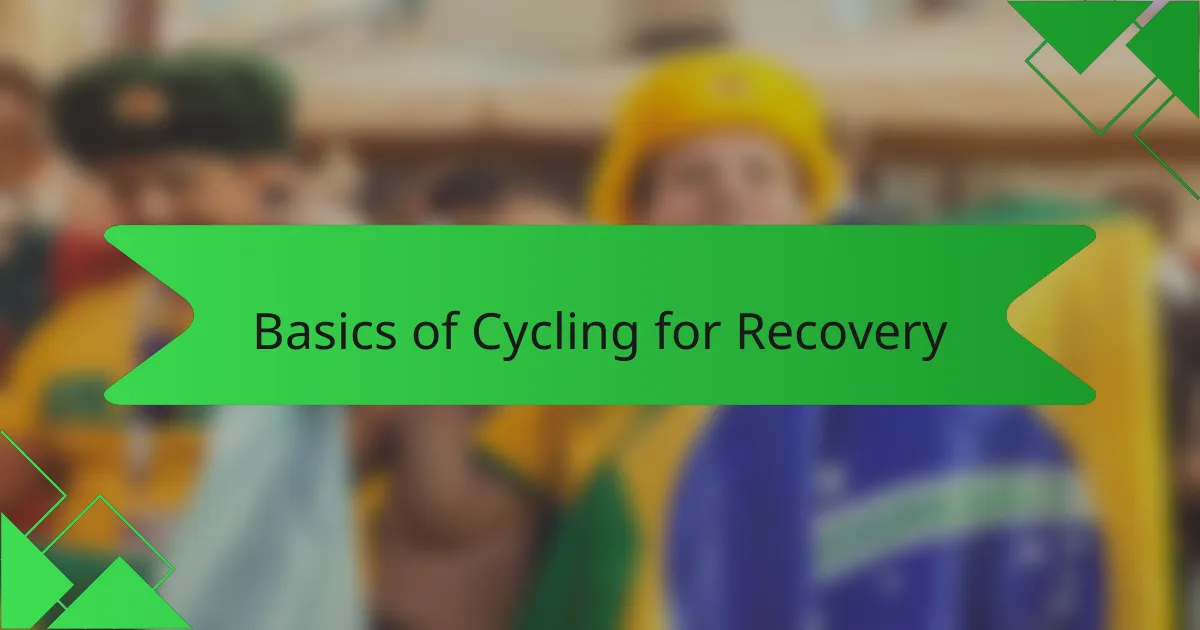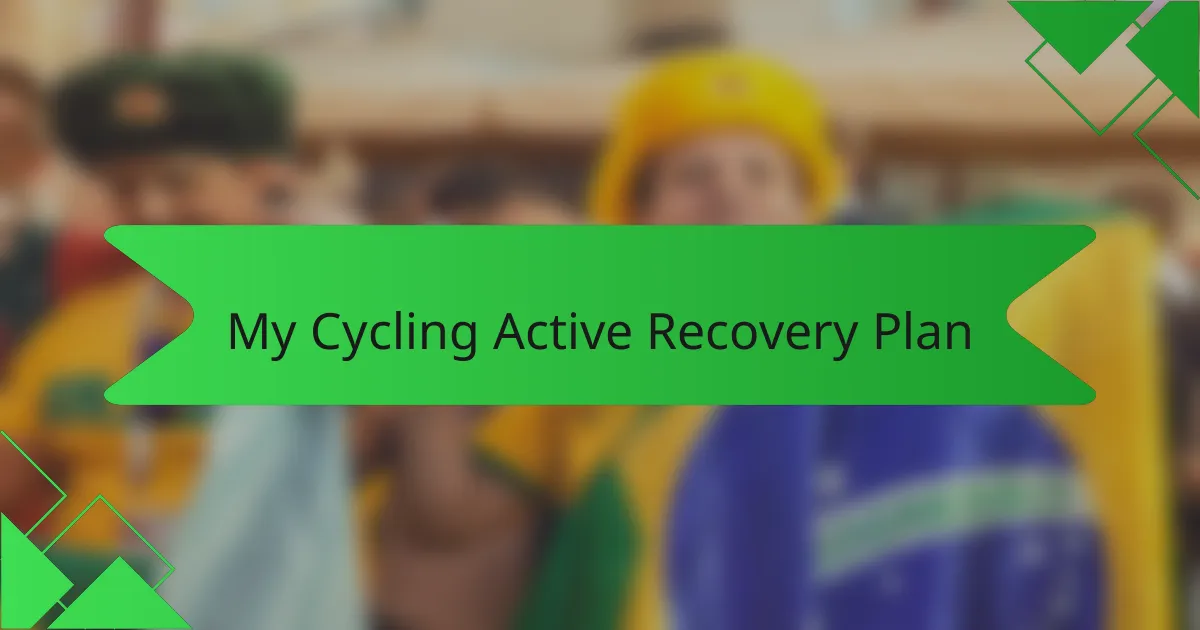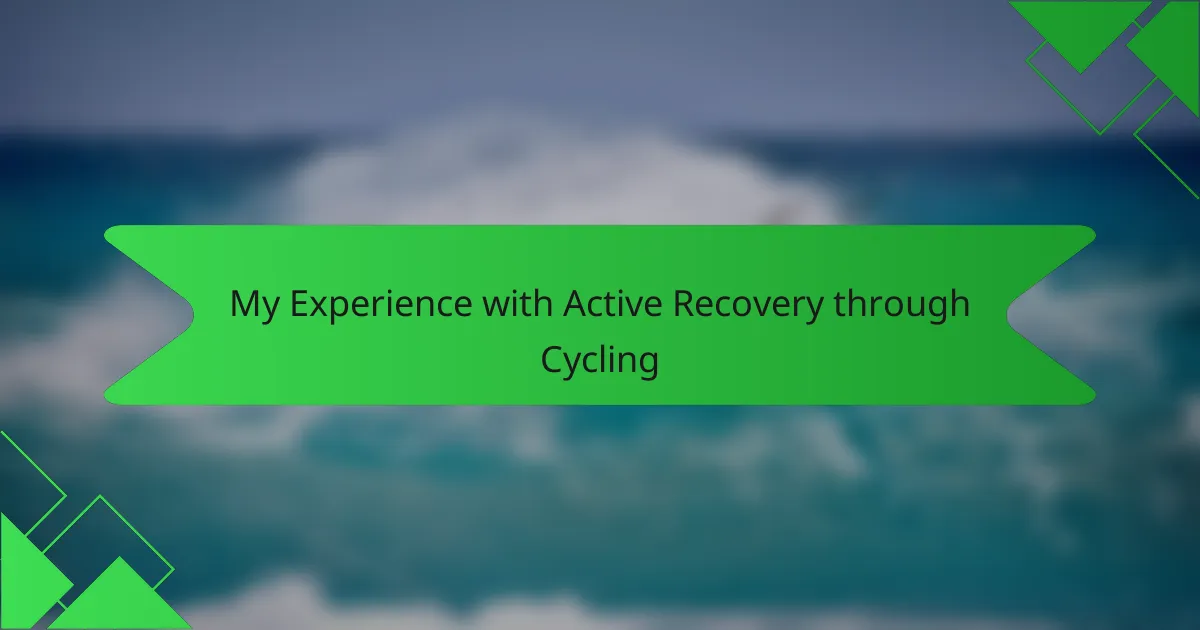Key takeaways
- Active recovery through low-intensity cycling promotes blood flow, reduces muscle soreness, and speeds up recovery without adding stress.
- Consistency is crucial; regular gentle rides enhance recovery and keep muscles flexible, ultimately improving overall performance.
- Listening to your body and maintaining a steady, low-resistance routine prevents overexertion and injuries during recovery.
- Cultivating patience and focusing on mindful movement are essential for effective recovery, transforming it into a vital part of training.

What is Active Recovery
Active recovery, from my experience, is a gentle way to keep moving without adding stress to your body. When I first tried active recovery through cycling, I noticed how it helped my muscles loosen up and reduced that heavy, tired feeling after intense obstacle course training sessions. It’s not about pushing hard; it’s about mindful movement that aids healing.
What I find fascinating is how active recovery encourages blood flow to muscles, flushing out waste and delivering nutrients that speed up repair. This isn’t just theory—I felt less soreness and faster readiness for my next race. Here’s what active recovery typically includes:
- Low-intensity cycling or other aerobic activities
- Stretching and mobility exercises
- Short duration and moderate effort, usually 20-45 minutes
- Focus on body awareness and breathing
- Avoiding any strain or high-impact moves
Cycling, in particular, has been my go-to because it’s low impact yet effective at keeping my legs moving and blood circulating without fatigue. Have you ever noticed how just a light pedal can shift your recovery from sluggish to refreshed? That subtle difference was eye-opening for me.

Benefits of Active Recovery in OCR
One of the biggest benefits I found with active recovery in obstacle course racing is how it helps reduce muscle soreness without the stress of a full workout. Have you ever ended a tough training day feeling so stiff that moving the next day seemed like a challenge? Cycling gently on those days felt like giving my legs a much-needed reset, washing away that heaviness.
Beyond easing soreness, active recovery boosts how quickly your body bounces back. I noticed that after a light cycling session, I didn’t just feel better physically; my energy returned faster, and I was mentally sharper for the next race or training block. That flow of fresh blood seemed to fuel more than just my muscles—it recharged my whole mindset.
Another surprising advantage I can’t ignore is injury prevention. When I incorporated active recovery regularly, I saw fewer nagging aches turning into real setbacks. Keeping my muscles moving at a low intensity felt like a secret weapon, keeping tightness at bay and enhancing flexibility. Isn’t it amazing how a simple, mindful pedal stroke can protect you in the long run?

Basics of Cycling for Recovery
Cycling for recovery is all about keeping your body moving without adding stress. I found that easy pedaling helps flush out muscle fatigue after tough obstacle course races. The smooth, rhythmic motion felt almost meditative, making recovery feel less like a chore and more like a moment of calm.
From my experience, focusing on light effort and consistent cadence is key. Instead of pushing hard, I aimed for a steady pace that kept my legs turning but didn’t tire me out. Here’s what I keep in mind when cycling for recovery:
- Maintain low resistance to avoid straining muscles
- Keep cadence steady, around 60-90 rpm, for optimal blood flow
- Limit sessions to 20-45 minutes to prevent overexertion
- Use flat or gently rolling terrain to reduce joint impact
- Listen to your body and adjust intensity based on how you feel
This approach helped me feel refreshed quicker and ready for the next race challenge.

Choosing the Right Cycling Routine
Picking the right cycling routine for active recovery made a huge difference in how my body responded after those grueling obstacle course races. I quickly learned that not just any cycling would do; the intensity and duration mattered a lot. For me, cycling too hard felt counterproductive, making my legs sore instead of refreshed.
I found it helpful to focus on easy pedaling and lower resistance, which surprisingly kept me motivated because I wasn’t fighting fatigue. Here are the key factors I paid attention to when choosing my cycling routine:
- Keep intensity low to avoid extra strain
- Stick to durations of 30 to 60 minutes to encourage blood flow without overdoing it
- Incorporate smooth cadence around 80-90 RPM to keep muscles engaged but relaxed
- Choose flat or gently rolling terrain to maintain consistent effort
- Avoid hills or high resistance days immediately after tough races
- Use a comfortable bike setup to prevent any additional muscle tension
This approach helped me genuinely feel better the next day and reduced stiffness, which I hadn’t expected before trying active recovery through cycling.

My Cycling Active Recovery Plan
When I developed my cycling active recovery plan, I realized that consistency was more important than intensity. Keeping the rides easy and enjoyable allowed my muscles to loosen up without adding stress, which surprisingly sped up my overall recovery from tough obstacle course training sessions. I often looked forward to these gentle rides, as they gave me a mental break as much as a physical one.
Here’s what my typical active recovery cycling plan looks like:
- Ride 3-4 times a week at a comfortable pace, focusing on smooth pedaling rather than speed
- Limit sessions to 30-45 minutes to avoid fatigue while still promoting blood flow
- Choose flat routes or stationary bike settings with low resistance to keep intensity low
- Include dynamic stretching and light mobility work before and after cycling to enhance recovery
- Use cycling as a way to clear my mind, appreciating the rhythm and scenery instead of pushing hard

Challenges Faced During Recovery
One challenge I often encountered during active recovery through cycling was managing the temptation to push too hard. It’s surprisingly easy to slip into intense efforts, especially when you feel good, but that can actually hinder the recovery process. I remember one particular week after a brutal obstacle course race when I ignored my body’s signals, only to feel more fatigued and sore the next day.
Another difficulty was dealing with the mental shift required for active recovery. I struggled with impatience and frustration, wanting quick results or to “just get back to training.” Cycling at an easy pace felt almost boring at times, but I learned to appreciate those moments as essential for healing and coming back stronger.
- Balancing effort to avoid overtraining
- Overcoming impatience with slow recovery progress
- Listening to bodily cues despite eagerness to push harder
- Managing frustration with reduced intensity workouts
- Finding motivation in repetitive, lower-intensity cycling sessions

Results and Lessons Learned
Seeing the results unfold was genuinely rewarding. I noticed my legs weren’t as heavy or stiff after race day, and the usual soreness that used to linger now faded faster. Have you ever been surprised by how simple changes—like easing off with gentle cycling—can lead to such noticeable recovery gains? For me, this shift not only helped my body but also restored my confidence in training smarter, not just harder.
One key lesson I kept coming back to was patience. It’s tempting to push through discomfort and call it progress, but active recovery taught me that rest with movement is an entirely different kind of strength. There were times when I battled frustration, wanting quicker improvements, but learning to trust the process ultimately paid off. It made me realize recovery isn’t a pause; it’s a vital part of the journey toward better performance.
Finally, consistency stood out as the game-changer. Skipping those easy rides or trying to rush the process often led to setbacks or lingering tightness. I learned that showing up regularly for low-intensity cycling sessions created a foundation that kept me ready for whatever the next obstacle course challenge threw at me. Isn’t it interesting how such a seemingly small habit can have such a big impact?
